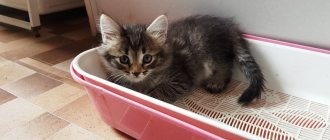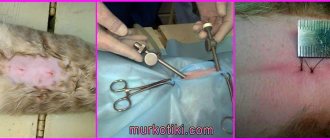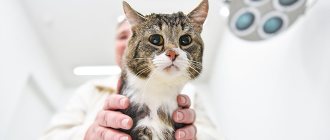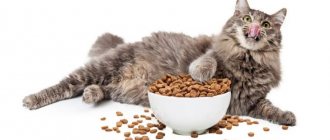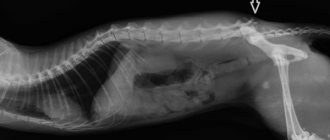What is sterilization
All operations involving the removal of reproductive organs from animals are called castration or sterilization. People often do not understand what sterilization and castration of cats are separately, and therefore do not separate the concepts, considering them equivalent. However, in medicine both concepts have their own definition.
Sterilization is the removal of the reproductive organs, but preserving the gonads. It turns out that the production of hormones remains at the same level, and sexual desire in cats is preserved. In this case, in cats, the fallopian tubes are tightened or the uterus is removed while preserving the ovaries.
Castration is the complete removal of the reproductive organs, including the gonads. As a result, the animal does not experience changes in behavior during puberty. When castration occurs, a cat's uterus and ovaries will be removed (ovariohysterectomy).
Note! If the gonads are preserved, the risk of uterine inflammation remains the same as before the operation. That is why castration, i.e. Complete removal of the reproductive organs, including the uterus, is considered the optimal way to protect the cat from neoplasms and inflammatory processes.
Differences between sterilization of young and adult individuals
When a female is spayed before her first heat, there is a high probability that only her ovaries will be removed during the operation. This operation is called oophorectomy. If at the time of the operation the cat was already in heat, or even pregnant and giving birth, then the uterus can be removed along with the ovaries during the operation. This procedure is called ovariohysterectomy.
According to the advice of veterinarians, it is better to remove the uterus during sterilization, because over time this organ can begin to become inflamed, which will lead to disastrous consequences. In order for the uterus to be removed along with the ovaries, it is not necessary to wait for the first heat. But before the operation, you need to consult a veterinarian and resolve this issue together.
There are cases where age does not play a role in sterilization. Most often this happens when surgery is prescribed for medical reasons. In this case, it is necessary to undergo tests to check the condition of the animal.
Video
Puberty in cats
Puberty in cats occurs from birth and reaches its peak at 6-10 months . This is the time of the first heat, during which the pet begins to “beg” the cat. 1-4 days before estrus, the pituitary gland begins to secrete a special hormone that stimulates the follicles. Estrogen accumulates in the follicles, which induce the animal to mate. In a cat, you can detect a decrease in appetite and clear discharge, and the genital mucosa is swollen.
A cat during heat can behave aggressively, often rushes at people, sleeps less - often sexual desire begins at night or in the morning. The cat makes characteristic sounds similar to howling, can meow loudly, and fall on its hind legs.
It is important! You should not assume that once the first heat begins, a cat can be mated with a male. At such an early age, the body will not tolerate pregnancy, and childbirth can be deadly for the animal.
When does a cat need to be sterilized?
Sometimes the veterinarian and owner have to make the decision to immediately neuter the animal, no matter how old it is and even if it is a breeding cat or a pregnant cat.
These cases are few and far between. Mandatory sterilization is required for a cat or cat that has:
- oncological diseases of the genital organs;
- benign formations of any location;
- breast tumors of various types of pathology;
In addition, the procedure is mandatory for an animal with a false pregnancy, as well as to correct the results of unsuccessful sterilization - incomplete removal of the genitals, resulting in repeated estrus.
All over the world, all street cats and kittens have long been sterilized, microchipped and vaccinated to prevent uncontrolled reproduction. Therefore, homeless animals are most often also sterilized as part of volunteer programs at any age and without expensive diagnostics.
Reasons for sterilization and is there an alternative?
Among the explanatory factors for sterilization are:
- Unwanted offspring - a cat can give birth to up to 9 kittens. Not all owners want to spend time on an extension, so they often throw it away or drown it. Cats are fertile and can give birth annually.
- Behavior control - if the animal lives in apartment conditions, puberty negatively affects the atmosphere in the family. It is really difficult to endure sleepless nights listening to cats scream and not stop loving your pet.
- Damaged renovation. Simple attacks by a cat on household members can result in marking of the territory, as a result of which people are faced with an unpleasant and irremovable odor.
- Prevention of sexually transmitted infections - veterinarians speak positively about sterilization, since this causes a decrease in the development of pathologies in 50% of cases.
- Increased life expectancy - sterilized pets live 2-3 years longer. Everything is explained by the absence of hormonal surges and “wear and tear” of the body during pregnancy and unrealized estrus.
Theoretically, you can do without abdominal surgery - we are talking about taking hormonal drugs that reduce the frequency of estrus in a cat. But this method does not always help; it often causes the development of pathologies, including the occurrence of polycystic ovary syndrome and diseases of the uterus. In addition, regular use of hormonal drugs reduces their effectiveness.
Note! Hormonal drugs are allowed to be given no more than 1-2 times a year. It will not be possible to prevent estrus with such a scheme.
There is another ineffective option - treating the cat with special sedatives. These are homeopathic herbal remedies, so they have only a superficial effect on the psyche - libido does not decrease.
As a result, the cat may feel lighter, but only for a short time. Such remedies include “Cat Bayun” and “Bach Drops”.
Types of cat sterilization
- Ligation of the fallopian tubes is currently an unpopular method of sterilizing cats, since this preserves estrus, the cat continues to attract cats, and there remains a high risk of inflammation of the uterus;
- removal of the ovaries (oophorectomy) - during this operation, the doctor removes only the ovaries, leaving the uterus. The cat's estrus stops. The risk of polycystic ovary syndrome and mammary gland tumors is, of course, reduced, but inflammation of the uterus still remains a threat to the cat;
- removal of the ovaries and uterus (ovariohysterectomy) is the most optimal operation from a medical point of view, which not only prevents unwanted pregnancy and elimination of estrus, but also minimizes or eliminates the occurrence of inflammation of the uterus, ovaries, mammary tumors, etc.
At what age should a cat be spayed?
Theoretically, a kitten can be sterilized by six months, since by 5 months the entire reproductive system reaches full development. But this is not recommended, since at such a young age the animal does not tolerate general anesthesia well. The most favorable and correct time for sterilization is 7-12 months . However, this can be done at any age in the absence of contraindications.
The older the cat, the higher the anesthetic risk . Anesthesia can provoke an exacerbation of chronic diseases and lead to the death of the animal. Therefore, it is better for adult cats over 8 years of age to undergo additional examinations before surgery as prescribed by a doctor.
Some breeds of cats tolerate anesthesia less well , so sterilization and castration become a serious milestone in the life of an animal. At risk: British and Scottish breeds, sphinxes, and white cats (they are more likely than others to have congenital pathologies of various types).
If you purchased a kitten from a nursery as a family pet, the contract may stipulate at what age the cat must be sterilized. In this case, sterilization is a guarantee that you will not engage in unauthorized breeding of the breed.
Practical advice! You should not delay the operation, since the process of hormone production increases the risk of developing pathologies that are dangerous to health and life. In most cases, cats are diagnosed with polycystic ovary syndrome, which is explained by the increased content of the hormone estrogen - its increase occurs in the absence of mating during estrus.
What age is optimal for sterilization?
Veterinarians generally agree that the optimal age for sterilization is seven to nine months.
They believe that with early sterilization there is a high risk of complications and consequences from anesthesia, since it is difficult for a kitten with a fragile body to endure surgical intervention.
There are certain statistics that with early sterilization, both males and females do not reach the size characteristic of their breed.
You can sterilize animals later - after 9-12 months, but the practice of veterinary clinics shows that it is better to do this earlier. After the first heat, the risk of complications increases by 10%, after the second, this figure doubles.
Can I be spayed during estrus, pregnancy, nursing or after childbirth?
Estrus is not a reason for refusal to sterilize - the cat will easily tolerate anesthesia, and hormonal disorders will not affect the animal's body.
Another thing is during pregnancy or after childbirth. The following factors need to be examined here:
- During pregnancy, castration is possible - removal of all genital and reproductive organs. This is explained by an enlarged uterus, in which the size of the blood vessels increases. The same applies to the fallopian tubes. As a result of the operation, the veterinarian risks damaging the ovaries and causing heavy blood loss, so specialists only undertake castration during pregnancy.
- After giving birth, a cat is sterilized only at a certain time. If a young mother is breastfeeding, she will have to wait until the end of the lactation period. If there is no litter, then it is enough to wait 3-4 weeks - during this time the uterus will return to its previous size.
- Sterilization is not carried out while feeding offspring due to the risk of injury to the mammary glands with subsequent infection of the wound.
From the above, it becomes clear that the most appropriate time to sterilize a cat is during estrus or after it ends without pregnancy.
How is the operation performed?
All surgical methods of sterilization (removal of the uterus and ovaries, removal of some ovaries and tubal ligation) are abdominal operations performed under general anesthesia, lasting 35-40 minutes. The animal does not feel pain.
Sutures (internal or external) are applied both with threads and with metal staples. The location and length of the incision depend on the sterilization method; the width of the seam ranges from 1 to 5 cm.
Caring for a cat after sterilization
In order for your cat to recover quickly after surgery, the following rules must be followed:
- It is necessary to provide her with a hard, comfortable bed.
- Do not disturb her sleep in the first few hours after surgery.
- It is advisable to stay close to the pet recovering from anesthesia, at least for several hours.
- Cover the cat recovering from anesthesia with a warm blanket, as at this moment its body temperature will drop significantly.
- Put a special bandage on your cat to prevent stitches from licking.
- Regularly (morning and evening) treat the seam with ointment prescribed by your veterinarian.
- If non-absorbable material was used during the operation, after 10 days you will have to go to the clinic to have the stitches removed.
- Be prepared for the fact that the very next day some cats may independently visit the litter box and move actively, although in most cases they most often lie in the place designated for them.
At what age should a cat be spayed?
When can a cat be spayed? This question (as well as the question of when to vaccinate a kitten) often worries caring cat owners.
There is no clear answer to this question. Recently, it has become fashionable to carry out early sterilization of kittens at almost two months of age. Proponents of this approach argue that at this age animals are not so sensitive to pain and their recovery after surgery is faster.
Opponents of early sterilization are convinced that this haste in the future will lead to improper formation and development of internal organs.
The most common point of view is:
- The most optimal time for sterilization is considered to be 6-8 months of age (during this period the animal reaches puberty).
- It is necessary to carry out the operation before the onset of the first heat.
- If estrus does begin, it is necessary to protect the animal from pregnancy.
- It is forbidden to perform surgery during estrus: this is fraught with the risk of dangerous complications. It is best to sterilize your cat a week later.
Is it possible to sterilize an adult cat?
Many pet owners who did not sterilize their pets on time and fear for their health often ask: “When should I sterilize a cat that is no longer a kitten?” Is it possible to sterilize animals that have already given birth, as well as older animals?
In principle, cats can be sterilized at any age. You just need to understand that the risk of developing many diseases in cats sterilized at an already mature age is many times higher than the same indicator in those animals that were operated on on time.
If an owner decides to sterilize an adult cat, he or she must carefully select a veterinarian and prepare for the fact that post-operative care will require more time.
Pros and cons of sterilization
There are advantages and disadvantages to sterilization that you should know about before surgery. The advantages of sterilization include:
- preventing unwanted offspring;
- decreased symptoms of hormonal surge - a sterilized cat suffers less because characteristic estrus does not occur;
- reducing the risk of contracting infectious diseases that are sexually transmitted;
- reduction in aggression - neutered pets are usually calmer and even a little lazy;
- the cat will no longer scream at night, ask for the cat and mark its territory;
- exclusion of oncological diseases of the uterus and ovaries during castration.
- the opportunity to continue the life of a pet.
The disadvantages include the following factors:
- effects of anesthesia - there are pedigree cats that do not tolerate anesthesia well (Maine Coons, British and Scottish Fold cats, Sphynxes);
- subsequent weight gain and risk of obesity - there are no hormonal surges, which means that physical activity decreases and appetite increases;
- the risk of infection in the wound during the postoperative period - it is important to provide complete care with treatment of the suture;
- incomplete removal of the ovaries during castration - estrus in this case will resume both after 1-2 months and after a year.
- possible rejection of the material - the animal’s body may not “accept” the threads used, which makes it necessary to operate on the pet again in order to eliminate the hematoma and change the material;
- the risk of damage to internal organs is primarily associated with the incompetence of the veterinarian.
Cat owners must decide what is more important to them - the health of their pet or the prevention of negative consequences that may arise from the wrong actions of a veterinarian. By choosing a qualified specialist with positive reviews, risks can be reduced.
How behavior will change
If for several years a female has had sexual intercourse with cats and given birth to kittens, then her behavior will not change immediately. After the first heat, estrogens begin to be produced not only in the ovaries, but also in the pituitary gland. Therefore, after the removal of the internal reproductive organs, hormones can be produced for several months in a row. However, this does not always happen.
In most cases, neutering cats has a positive effect on their behavior. Pets become calm and less likely to show aggression towards people and other animals.
In sterilized females, sexual attraction to males disappears. They don't mark territory.
Cats that have free access to the street stop running away from home. They don't get into fights. The risk of contracting sexually transmitted diseases is minimized.
The female, who no longer produces estrogens, leads a passive lifestyle. She sleeps a lot and has a good appetite. To prevent your animal from gaining excess weight, you need to properly organize your diet.
How to prepare a cat
Sterilization is an operation that requires careful medical preparation. Preparation is necessary due to the anesthesia used. As a result, the pet owner should take the following actions:
- Undergo tests and ultrasound to identify possible contraindications to surgery. An examination is ordered by a veterinarian who suspects possible abnormalities in the cat.
- It is important to see a cardiologist - this will reduce the risk of cardiac arrest during surgery.
- The cat is not fed 12 hours before surgery.
- Stop giving water 2-3 hours before surgery.
- It is recommended to wash furry cats thoroughly before surgery to minimize the risk of infection in the wound.
Veterinarians shave the cat's belly hair and perform a thorough grooming before surgery, but extra precautions are also important.
Brief description of the operation
To minimize possible complications, preparatory measures are recommended. They include not only actions immediately before surgery, but also ongoing disease prevention. In particular, this refers to annual vaccination.
Preparing the animal
Anesthesia weakens the immune system, increasing the risk of infection by harmful microorganisms and parasites. For safety, it is recommended to vaccinate your pet at least a month before the procedure. Treatment for helminths is carried out within 1.5-2 weeks. In the absence of timely vaccination, the cat is given a serum injection that stimulates a stable immune response for 2 weeks.
A few days before surgery, a urine and blood test is taken from the tailed patient. To determine the safe dosage of a narcotic substance, the functioning of the heart and respiratory organs is checked using ultrasound and x-rays.
It is recommended to give up feeding 12 hours before, and water 3 hours before. This eliminates the occurrence of vomiting, which provokes the development of aspiration pneumonia.
Choosing a clinic and veterinarian
Pets that don't go outside are afraid to leave their familiar territory. To minimize stress, it is better to choose a clinic closer to home. Walking distance will eliminate travel by transport, reducing the time you spend outside your usual conditions.
For especially timid pets, calling a veterinarian to your home is a good idea. This eliminates the stress caused by a change of environment and the risk of infection from other visitors. The disadvantage of home surgery is the low sterility and lack of equipment necessary to eliminate possible complications. Most clinics provide both types of services, so the choice is up to the owner.
It is ideal if you vaccinate your animal and take it for routine examinations to the same clinic and to the same doctor. A regular veterinarian is familiar with the characteristics of the body.
Progress of the procedure
After anesthesia is administered to the tailed patient, the hair is removed at the site of the future incision or puncture. The procedure itself is carried out in two ways:
- surgical, involving classical excision with a scalpel;
- laparoscopic, based on the creation of small punctures using endoscopic equipment.
In both cases, after making an incision, the surgeon removes the reproductive organs and applies stitches. They are removable and non-removable. The first ones are removed 7-10 days after the procedure, and the second ones resolve on their own.
Where is it better to carry out operations: at home or in a veterinary clinic?
Of course, only a doctor with the appropriate education can operate on a cat. However, this can be done in a veterinary clinic or at home - which is better?
of surgery in a veterinary clinic include:
- there is a sterile operating room - this minimizes the development of infection;
- the cat is placed in the postoperative unit, where proper care is provided;
- the chances of quickly solving the problem of an emergency situation are increased, thanks to the availability of the equipment necessary for this.
Disadvantages include travel costs and the owner's wait time in the clinic's hallways.
Despite the positive aspects of having the procedure done at a veterinary clinic, some veterinarians prefer to sterilize at home. Firstly, they do not have a room to receive patients. Secondly, it is cheaper, so there is more clientele.
The advantages of surgery performed at home include:
- lack of stress in the pet before surgery;
- no risk of contracting viral and infectious diseases that a cat can get in the veterinary clinic itself;
- the ability to schedule the operation at a more convenient time for the owner.
Among the disadvantages, the only highlight is the lack of ability to ensure high-quality sterility.
Note! On-site veterinarians use a minimal set of tools and materials, which is why if a complication occurs during surgery, they will not be able to provide assistance properly. It is also noted that not all veterinarians working on field trips have the appropriate license to conduct operations.
How to avoid the consequences of cat laparoscopy
- Do not try to save money on such an operation, and it is quite expensive compared to sterilizing a cat using the classical method. If you have already decided to sterilize using laparoscopy or your cat needs it for medical reasons, then think about what instruments, under what conditions and what qualifications the doctor will operate on your animal if the price is too attractive or below the average.
- The limited range of motion of the surgeon during such an operation, the decrease in the tactile sensitivity of the doctor’s hands - all this requires a highly qualified doctor who will perform the operation on your pet. Take the time to find out the experience of performing such operations in the clinic and reviews from patients who have already undergone such an intervention.
- Some veterinarians may suggest doing the surgery at home. Don't agree! We should not forget that laparoscopic sterilization is, although gentle, with minimal intervention, still a surgical operation performed under general anesthesia.
- If the veterinarian assures you that preparation for such an operation is completely necessary, and you can bring your cat even now, run away from such a would-be doctor. The preparation is at least minimal, but it must be there. If you don’t understand why, then carefully re-read point 3 of this list.
Features of the operation
There are several types of surgical interventions that allow you to sterilize an animal - abdominal surgery, using a hook and laparoscopic surgery. Each method has advantages and disadvantages that will help pet owners decide on their choice.
Abdominal surgery
Abdominal surgery is a classic method that is performed in the following sequence:
- An incision measuring up to 3 cm is made in the center of the abdomen - 2-3 cm below the navel.
- The abdominal wall is cut along the white line.
- The uterus is removed through the resulting incision.
- A ligature is applied to damaged vessels using self-absorbable material.
The advantages of the operation include good visibility of the abdominal cavity - the doctor will be able to remove organs with minimal risk of damage to internal organs. During surgery, a special material can be used that does not require the removal of sutures.
The only disadvantages include serious damage to the skin and abdominal wall, which is why recovery will last for 1-2 months.
This is interesting! The method can be improved somewhat by making an incision on the side. In this case, the internal muscles are separated in a blunt way, which is less traumatic - recovery occurs faster.
Through an ultra-small incision using a surgical hook
This method carries the risk of incomplete removal of the uterus. The operation sequence is as follows:
- On the abdomen, as in the first case, an incision of less than 1 cm is made.
- A hook is lowered into the resulting wound.
- The hook grabs the uterus and pulls it out.
- Next comes the application of ligatures.
- The uterus is removed.
The advantages of the presented method are the ability to reduce the size of the seam. But this is not a compelling argument, since the skin and abdominal wall are also injured, and the risk of damage to internal organs with a surgical hook increases.
Laparoscopic sterilization
If desired, you can subject your cat to laparoscopy, a more modern method of sterilization that requires expensive equipment. The operation is technically complex, but entails less trauma, which means quick recovery of the operated animal.
During the operation, endoscopic instruments are used that only puncture the skin and abdominal wall. Through punctures, with the help of displaying a picture on the monitor screen, the genital organs are removed.
The advantage of the operation is the absence of stitches and quick recovery. Disadvantages - the method is not widespread in Russia, therefore it requires a more significant monetary contribution.
Cat behavior after surgery
After the operation, veterinarians put a blanket on the cat and send it home with the owner - this happens if there are no obvious signs of complications after surgery (the bleeding has stopped). Next, the owner needs to monitor the behavior of the pet, where the following recommendations are observed:
- The cat is transported home on its side after an anesthetic injection.
- At home, the pet is placed on a blanket or blanket, which is first laid on the floor - the patient should not be carried to high surfaces, as she may fall.
- Positioning on your side for the first 1-2 hours will help prevent vomit from entering the trachea if any occurs. If they occur, the cat needs to thoroughly clean its mouth.
- It is important not to catch a cold, both during transportation home and after. Otherwise, you may encounter an inflammatory process.
- The house should not be too warm or cold - the room temperature is from 20 to 24 degrees.
- After a few hours, the operated animal will begin to move around - it can be slow and lacking coordination or, conversely, excitedly running around the house.
Note! The cat feels good if during the first 2-3 days it starts drinking water and eating small portions. During this time, she may not have bowel movements, and urination will be rare and scanty - everything will return to normal with a full return of appetite.
Often, after sterilization, a cat does not feel well. This could be:
- Constipation - it is necessary to give a laxative if the pet did not go to the toilet in the first 3-4 days after surgery.
- An increase in temperature is possible in the first 5 days, due to injury to the skin and abdominal wall. You can help the animal by giving it pain relief. If the temperature does not subside within 7 days, consult a doctor - infection is possible.
- Lack of appetite – appetite should normalize within the first 5 days. If this does not happen, you should contact your veterinarian.
In the first days the cat will be lethargic - this is normal, but the condition should gradually improve. If the animal becomes less and less active, you should immediately contact a veterinarian.
Possible consequences when sterilizing older animals
Thanks to the achievements of modern veterinary surgery, negative consequences after surgical treatment are rarely observed. Most often, complications arise due to medical errors or improper care of an elderly pet after an oophorectomy or ovariohysterectomy.
If you sterilize a female at 6 years of age or older, the following consequences are possible::
- changes in body temperature (impaired thermoregulation);
- inappropriate behavior after surgery;
- infection in the incision area;
- inflammation of the suture;
- peritonitis;
- indigestion;
- hernia;
- development of viral or bacterial pathologies due to weakened immunity;
- heavy breathing with wheezing;
- allergies to anesthesia (swelling, rashes);
- suture bleeding;
- heart failure;
- kidney problems.
After sterilization, the old cat will be lethargic and drowsy. Often the pet refuses food for 2 days. She constantly vomits, often with foam. These are the consequences of anesthesia. If they do not disappear after 2-3 days, you should seek qualified veterinary help.
In old and elderly animals, the weak points are the kidneys and heart. When using anesthesia drugs, the load on the myocardium increases. Therefore, before surgery, the cat must be carefully examined and the pros and cons of surgery must be weighed.
Postoperative care
Postoperative care lasts for a month, during which the pet should feel better. Proper care requires compliance with the following rules:
- The cat should be fed after surgery in small quantities, but with the same food that was given previously. It is not recommended to give dry food in the first days.
- After surgery, the animal must wear a blanket or a special collar. Owners should take care of their safety to prevent the licking of medications used to treat the stitches. Protective equipment is removed 10 days after sterilization. If there is a need to remove stitches, they go to the clinic.
- During the first two days, it is recommended to give the cat painkillers - it is better to give injections. Procedures are discussed with the veterinarian.
- During the entire healing time of the sutures, it is important to check their condition. In the first days, the seam may turn red, swelling may occur, and ichor will appear. This should go away by 7-8 days after surgery. If there is no improvement, consult a doctor.
- The owner must treat the seams for up to 10 days - treatment is carried out with chlorhexidine every 2 days, preferably every day. This is necessary to prevent infection.
If you have any questions, you should contact the veterinarian who operated on the animal. It is better to show the patient for a personal examination by a specialist.
Advantages of laparoscopic sterilization of cats
- The operation is gentle and can be performed on cats from 6-7 months to 13-15 years;
- due to minimal surgical intervention, the risk of infectious postoperative complications is practically reduced to zero;
- minimal postoperative care for sutures (treatment 1, maximum 2 times) or complete absence thereof;
- the absence of a large incision minimizes the cat’s postoperative pain;
- a milder prophylactic course of antibiotics compared to the course after abdominal surgery;
- no need to wear a postoperative blanket;
- sutures are applied with special threads that dissolve on their own, or there is a special glue that is used to seal surgical punctures;
- the animal returns to its normal lifestyle as quickly as possible after surgery.
Cost of the procedure
The cost of the operation varies depending on the status of the clinic and the sterilization method used. The average price ranges from 1,500 to 5,000 rubles. The use of absorbable sutures increases the cost of the operation, but avoids difficulties in the postoperative recovery of the cat.
If owners do not want to breed kittens, they must have the cat spayed. The presented operation will help prevent the development of numerous animal health problems. Otherwise, more serious and expensive operations will be required.
When should sterilization be carried out?
There are several theories justifying the timing of this operation:
First theory (early sterilization)
Some scientists believe that to prevent future health problems, sterilization should be carried out before puberty (before the first heat). The optimal period for this operation is from 3 months to six months. At this time, all genital organs are well defined, which makes them easy to manipulate.
However, there are also negative arguments: a cat that has not reached puberty experiences irreversible changes in hormonal levels. The development of the reproductive system is directly related to the hypothalamus, which is responsible for behavioral reactions. In some cases, the animal may become unpredictable and cannot control its behavior.
On the other hand, for young individuals the operation is easier, and surgical sutures heal faster. With early sterilization, animals experience fewer postoperative complications.
Second theory (sterilization after puberty)
Other experts believe that such early sterilization can lead to negative consequences. Cats may experience problems with the endocrine system, deteriorate kidney function, or develop pathologies in the retina. Such an early stage of the operation also interferes with the normal development of the body, causing disproportionate development of the body and slowing down the growth of the head.
These experts believe that the operation should be performed after the first heat. It has been proven that these terms can reduce the risk of tumor formation in the mammary glands by 25%.
Third theory (sterilization after a year)
There are also a number of scientists who propose to wait with the sterilization procedure and carry out it on animals older than one year. At this time, their body was already fully formed and strengthened for such a significant test and shock.
